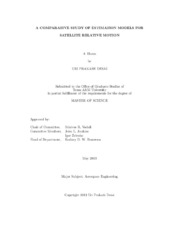| dc.description.abstract | The problem of relative spacecraft motion estimation is considered with application to various reference and relative orbits. Mean circular and elliptic orbits are analyzed, with relative orbits ranging in size from 1 km to 10 km. Estimators are built for three propagation models: (i) Gim-Alfriend State Transition Matrix, (ii) the J2-Linearized Equations of Motion for Circular Orbits, and (iii) the Clohessy-Wiltshire Equations of Motion. Two alternative models were developed in an attempt to ac- count for unmodeled nonlinearities: (i) Biased Clohessy-Whiltshire Equations, and (ii) J2 -Linearized State Transition Matrix. Two estimation techniques are presented in an attempt to explore and determine which propagation model minimizes the error residual: the linear Kalman filter is presented under the assumption of vector based, GPS-type measurements; the extended Kalman filter is analyzed assuming angle-range, optical-type measurements. Sampling time is varied to look at the effect of measurement frequency. It is assumed that the orbit of one of the satellites, the chief, is known reasonably well.
This work showed that the error residuals from the state estimates were minimized when the propagation technique utilized was the Gim-Alfriend State Transition Matrix. This supports conclusions that are obtained outside of the estimation problem. Additionally, the error residuals obtained when the propagation technique was the Clohessy-Wiltshire Equations is comparable to the more complicated models. Unmodeled nonlinearities affect the magnitude of the error residuals. As expected, the Gim-Alfriend STM comes closest to the truth; for smaller eccentricities (0.005), the Clohessy-Wiltshire EOM show minor deviations from the truth. As the eccentricity increases, the linear models begin to diverge greatly from the true response. The additional two models (the biased CW equations, and the linear STM) show decent performance under specific conditions. The former accounts for some of the unaccounted for nonlinearities. The latter exhibits comparable performance to the Gim-Alfrien STM for circular reference orbits. However, in each case, as the nonlinearity of the problem increases, the accuracy of the model decreases. | en |


